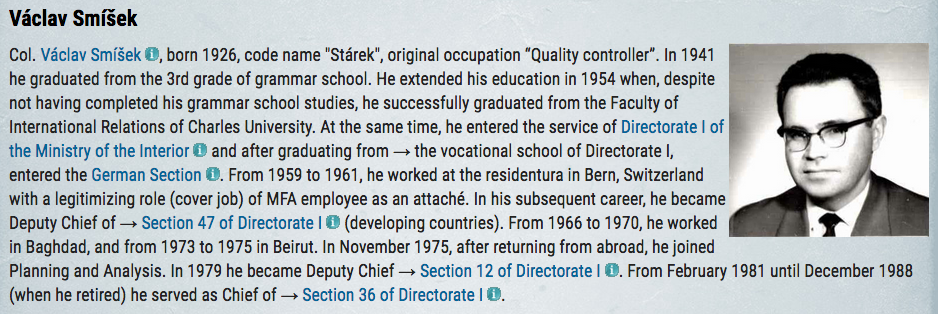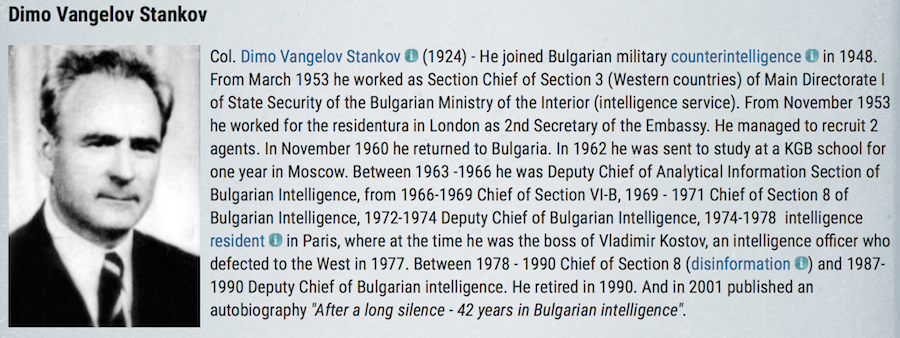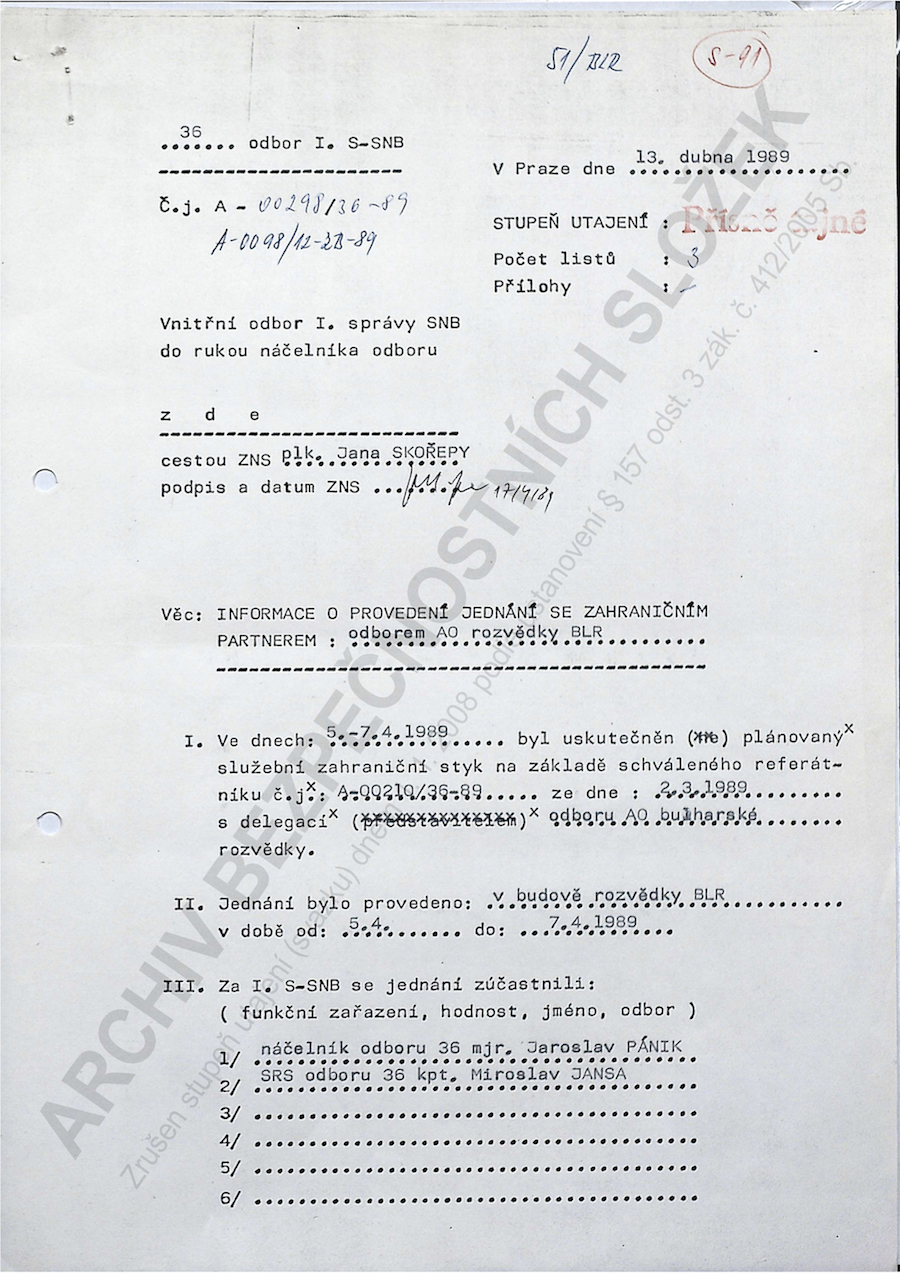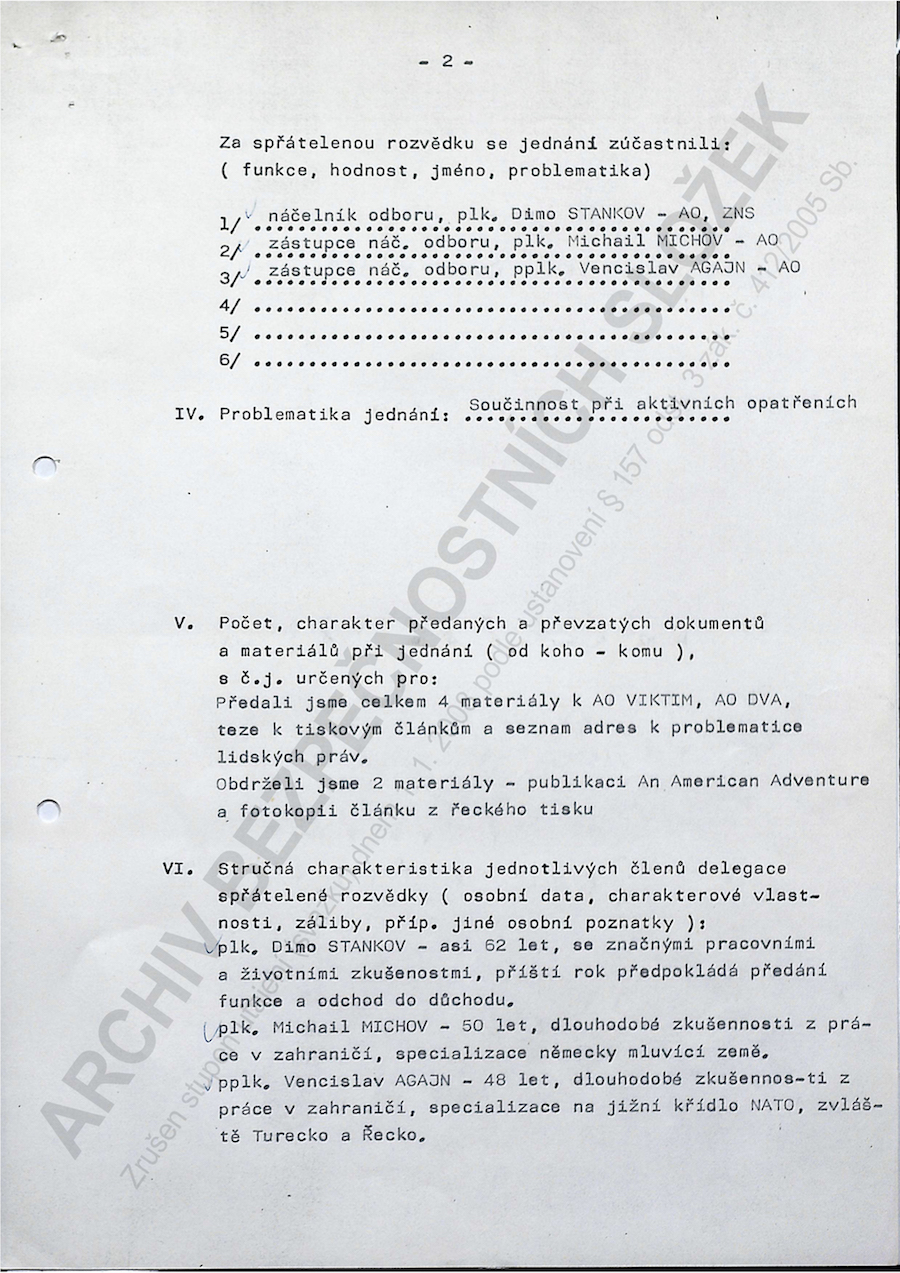The main enemy. Active measures against the United States of America and NATO
The struggle against the United States (US) and the North Atlantic Treaty Organization (NATO) was an absolute priority in the work of communist intelligence. The area of active and influence measures was no exception.
The term "main enemy" was officially used in documents of the Czechoslovak Ministry of the Interior (in international and internal documents, orders, directives, files, and ordinary documents).
Upon closer consideration, this term does not sound very natural. It was, however, in the direct diction of the ceremonial, propagandistic formalism of the regime of the time. It was to underline the importance attached to the need to fight the adversary defined in this way, the greatest threat to communist regimes. It could also serve as a good psychological window into the paranoid thinking of the communist leaders, who advocated and required such terms. The enemy at home was anyone who expressed a desire for freedom. The external enemy was the free world just because it existed. And if democratic countries decided to contend with inhumane, human rights suppressing communist regimes, the leaders of such totalitarian regimes' need for declaratory naming of the enemy became even more pronounced. The "main enemy" was always mentioned in the introductory parts of documents that directed the activities of the intelligence services and had a decisive impact on their activities. In the Czechoslovak Intelligence Directive for Operations Abroad from 1964 (approved by Interior Minister of the time Lubomír Štrougal) the main enemy is defined as:
“Based on the balance of power in the world and the perspective of its development, and on a consistent concept of party orientation and proactiveness in intelligence work, the primary task of Czechoslovak intelligence is to fight against the main enemy on a global scale. The main enemy is that imperialist state or group whose forces and means (including scientific and technological potential) are the decisive basis for organizing and coordinating aggressive military, economic, political and ideological actions against
- the socialist system as a whole,
- against Czechoslovakia as a part of it,
- progressive forces in any part of the world,
- national liberation movements.
In the present context, the general conception of main enemy is the USA. The aim of the work of Czechoslovak intelligence must accord with this, across all sections. In individual cases, it is necessary to take into account also specific tasks of primary importance for Czechoslovakia. In the European arena for example it is necessary to focus active measures especially against West Germany and the aggressive NATO group”.
 This articulation and definition remained unchanged until the end of the communist regime in Czechoslovakia. It adapted to developments on the international political scene, and so gradually in the early 1980s even Communist China came to be counted among the main enemies. But in the first place until November 1989 "... are under the current conditions, the United States of America and the NATO pact organized by it, whose leading member in Europe is the Federal Republic of Germany". (→ Guidelines for intelligence work of Directorate I of the SNB, 1983). The struggle against the main enemy was an integral part of Communist intelligence operations.
This articulation and definition remained unchanged until the end of the communist regime in Czechoslovakia. It adapted to developments on the international political scene, and so gradually in the early 1980s even Communist China came to be counted among the main enemies. But in the first place until November 1989 "... are under the current conditions, the United States of America and the NATO pact organized by it, whose leading member in Europe is the Federal Republic of Germany". (→ Guidelines for intelligence work of Directorate I of the SNB, 1983). The struggle against the main enemy was an integral part of Communist intelligence operations.
US presidential elections
Today, Russia's influence on US presidential elections is quite frequently and openly discussed. Even this is not a new phenomenon. Logically, the communist secret services also focused on the election of the world's "most powerful president". Czechoslovak intelligence service training materials from the mid-60s1 on the implementation of active measures (AM) state:
“Consider the situation before the US presidential elections in 1964. We know what role the US President plays. It is clear that no American citizen who takes up such position can pursue a completely independent policy without any connection to anyone else. He is subject to a whole range of pressures, both from Congress and the Pentagon, the State Department, individual advisors, intelligence services and the like. Maintaining maximum personal independence depends on the strength of the president's personality. It is understandable that we could not be indifferent to which presidential candidate won. There were many differences between Johnson, Rockefeller, Goldwater, Lodge and the others. Simply put, we had to determine which of them was the lesser evil. Therefore, Goldwater was identified as the main target for our active measures with the aim discrediting him to the maximum extent possible.”
It is, of course, a pity that due to the state that materials regarding executed AMs are in today2, we do not have any specific documents about Barry Goldwater. It is not even possible to ascertain from the available documents whether these operations took place directly on US soil. However, there are still documents from other operations which can serve to demonstrate the struggle of communist intelligence against the US and NATO.
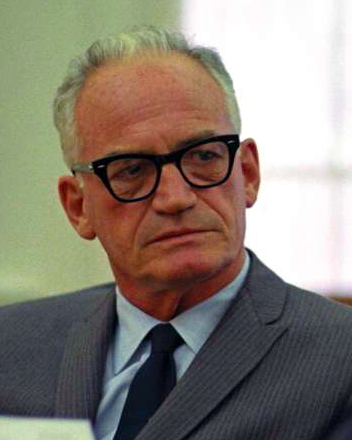 Barry Morris Goldwater (1909 - 1998)
Barry Morris Goldwater (1909 - 1998)US Republican Senator for the State of Arizona (1953-1964, 1969-1987) and Republican Presidential Candidate in 1964. As a conservative Republican, he called for a tougher diplomatic stance against the USSR, and opposed negotiations on arms control. He won several key primaries in the presidential campaign of 1964 and won the Republican presidential nomination after the very first vote. He campaigned against President Lyndon B. Johnson. In the end, to his detriment, he was accused of being an extreme anti-communist who could lead the country into a war against the USSR.
Under the direction of the KGB
From its very inception in 1953, the focus of activities of → Directorate I of the Ministry of the Interior was action against the "main enemy" – efforts to weaken it and discredit it in the eyes of its allies and the public. After overcoming the "crisis period" associated with the invasion of Czechoslovakia by Warsaw Pact troops, operations comprising active measures against the "main enemy" resumed with their original intensity in the second half of the 1970s. Coordination with the actions of Friendly communist services was much better, and the various ambits and objectives were discussed at Eastern Bloc meetings under the guiding hand of Moscow. At the end of the 1970s and in the early 1980s3, the activities of Section 36 were based on the conclusions of deliberations of socialist community council delegations in Moscow on 17-24 September 1979, where a Final Document on Active Measures set out the following tasks:
- averting the possibility of a global ballistic conflict, moving Western governments' political and public circles to more realistic positions in all aspects of the politics of peaceful coexistence,
- weakening the US's position in Western Europe and other key areas of the world, intensifying conflicts within NATO,
- opposing the political and military integration of the common market countries and preventing the most reactionary circles from taking the lead in Western Europe;
- providing support to national liberation movements in Asia, Africa and Latin America;
- revealing the intrigues of the Beijing leadership,
- discrediting and compromising the activities of enemy intelligence services, centers of ideological diversity, emigrant and Zionist organizations, unmasking the actions of special services of Western countries aimed at assisting dissents and the 'protection of human rights'4
The objectives of the “Final Document” as well as the agreements reached by representatives of → Directorate I of the FMV in Moscow were incorporated into the annual work plans of the Centre and residenturas and were transformed into specific "long-term active measures". Cooperation with Soviet intelligence in the fight against the main enemy included AM "Sepia" and AM "Long". Other specific active measures were also carried out within these AMs. AM "Sepia" involved:
- Unmasking the reactionary politics of the USA
- Revealing US politics of power and dictation
- Discrediting US military-political strategic plans within NATO
- Discrediting of Reagan's doctrine of the fight against terrorism as a tool against the USSR and progressive revolutionary national liberation movements
- Preventing the expansion of US nuclear potential and discrediting aggressive US foreign policy interfering in the internal affairs of other states.
The aim of the long-term AM "Long" was to "work on" the North-Atlantic alliance. The active measures implemented by Directorate I of the FMV in this case focused on the southern and south-eastern wing of NATO, in particular on maintaining tensions in Greek-Turkish relations by using the Cyprus question. In this context, the intelligence carried out e.g. the press related AM MARE in Cyprus (1981), which was extended to Greece and the Greek lobby before the US Congress. Material supplied by the Soviets with the following title was used for this operation: "The trampling of fundamental human rights and freedoms of citizens of Cyprus by foreign intervention".
The article alleged the abuse of Great Britain's military bases in Cyprus by US forces. 5 AM ZBOR, implemented by the Czechoslovak intelligence service in February 1981, was also one of its most highly evaluated operations, involving the publication of top-secret materials about the command plans for US troops in Europe. The materials were supplied by the KGB and printed in Czechoslovakia. The material was then further disseminated and distributed in Great Britain and other Western European countries. Similar methods were used in AM BOR, which involved the use of secret materials about the placement of missile bases provided by the Soviet side. The residentura in Brussels handed them to their agents in the Belgian Parliament.6
Active Measure BRITZ
In the first half of the 1980s, consideration was given to reducing the number of conventional military forces in Europe. More than 600 organizations, both various peace movements and various other societies, received a brochure entitled "Soviet military power? Allegations and facts". The "Greens" in West Germany were indicated as the senders. This was a real organization and the envelope bore the organization's emblem, which had been used in the past in the distribution of their leaflets, which protested the placement of US missile bases in West Germany. In this case, however, it was part of AM 'Britz' of Section 36, Directorate I of the FMV. The printing of the brochure on "paper produced abroad" as well as the printing of envelopes was arranged by the Section's technical group.
The leaflet contained statements by American politicians and military leaders in the past, referring to the military superiority of the West, supplemented by graphs and statistics to prove "the falsehood of the claims of military superiority of the USSR and Warsaw Pact allies". The wording of the material was composed by the Active Measures Section of the 1st Chief Directorate of the KGB. Five thousand copies of the brochure were printed, containing text in English, French and German.
Czechoslovak intelligence handed half of them over to the Soviets for their own needs, and sent the rest to selected addresses. Czechoslovak intelligence's Paris residentura also arranged for a translation of the brochure into Turkish and this language version was distributed during a march of Turkish minority members organized by a French peace movement. The intelligence service also arranged a Greek language version, distributed to selected addresses of various organizations in Greece, where the full text of the leaflet was published on 8 November 1983 in the Apogevmatini daily. The AM was terminated after an operational meeting between representatives of the AM intelligence departments of the Czechoslovak Socialist Republic and the GDR in Cínovec, when "the German side drew attention to printing and linguistic errors in the German version and recommended that the AM be discontinued".7
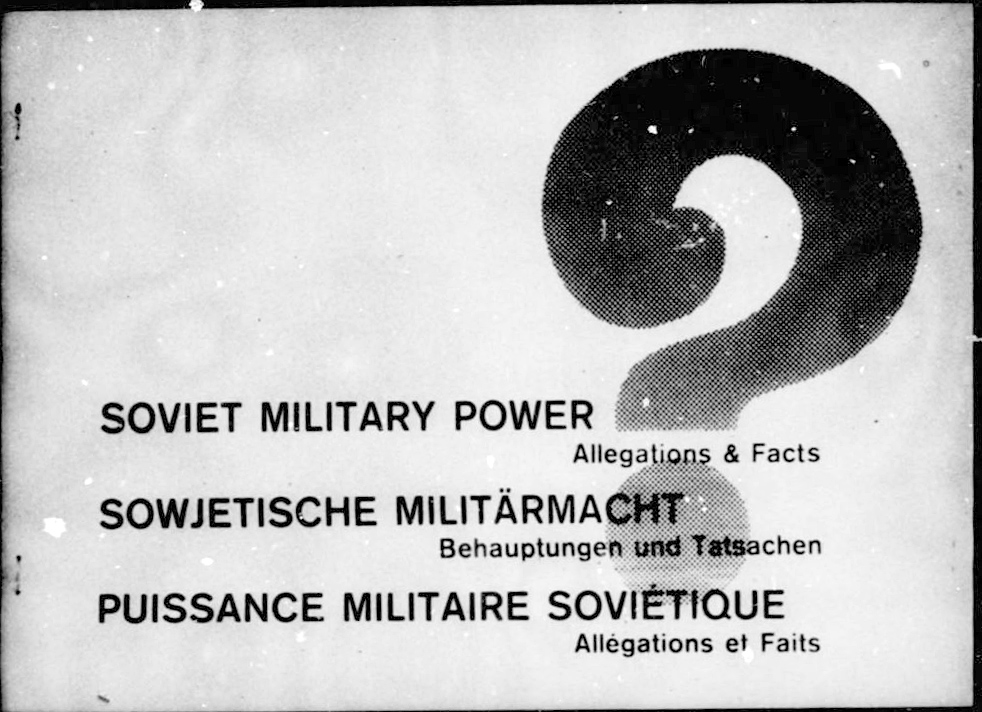
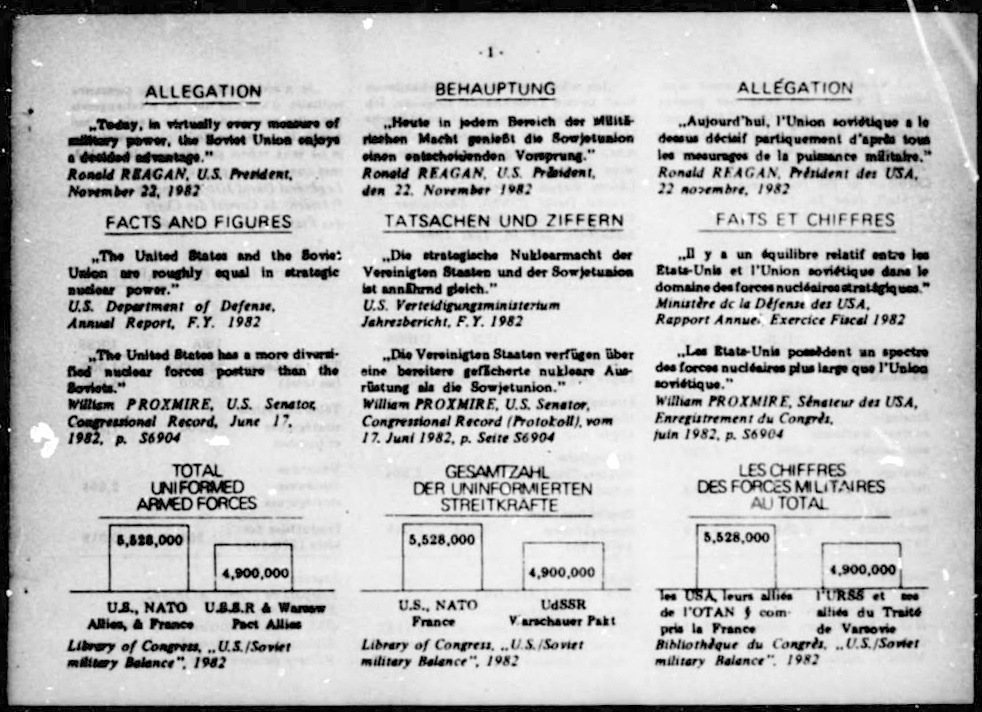
Active Measure DVA
In March 1983, when President Ronald Reagan introduced the Strategic Defense Initiative (SDI) project to the US and the world, it sent shock waves through the international political scene. The project known as Star Wars meant the rejection of the then-current concept of international security, paradoxically based on the threat of assured mutual destruction through the exercise of nuclear potential. The US SDI immediately became the number one issue for all Eastern bloc intelligence services, and in addition to the massive → operation RYAN, communist countries launched a wave of active and influence operations aimed at the broadest possible influence of public opinion in Western Europe.
In October 1984, Col. Vladimir Ilyich Gorovoj (advisor to the KGB working at the Ministry of the Interior in Czechoslovakia) received, through the internal mail of the Ministry a letter from the chief of Czechoslovak intelligence Major Gen. Karel Sochor, in which the Chief informed him that Section 36 (active measures section) of Czechoslovak intelligence was preparing to release a publication in certain parts of Western Europe, which was to offer readers "ready answers" to the questions:
- Is the Soviet military threat fact or fiction? What would happen if the virtual strategic balance were upset?
- Has something been achieved by not holding mutual disarmament negotiations? Or, how acting from a position of power leads to a dead end.
- Is there a real possibility of outdoing the USSR in armament? Has Reagan's arms spending program made the world a safer place, or has it caused global peace to become more fragile since its implementation and ramped up the threat of a global nuclear conflict?
- Why do some strata of the American ruling class feel nuclear warfare is unavoidable, and why do they want it? Or: the likelihood of limited, long-term cosmic and nuclear warfare from the perspective of an expert.
- The survival of the planet requires a reduction in the level of armed forces and weapons. Armament will not benefit anyone because threats to the USSR and other countries will mean greater threats to the US.8
Sochor also informed the Soviet advisor that "the text will be written from the perspective of a West European liberal with an estimated length of 80 to 100 pages. ... I provide this information with a proposal of cooperation whereby we will send the text piece by piece as it is written for your review and possible comments".9
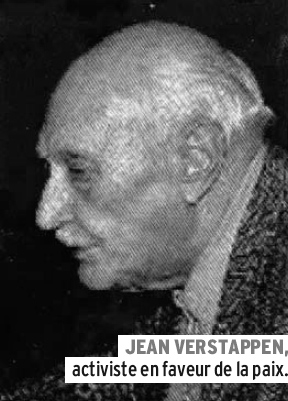 Fig. Jean Verstappen, Photo: fondspourlejournalisme.be
Fig. Jean Verstappen, Photo: fondspourlejournalisme.be
This letter to the KGB advisor kicked off the implementation of AM DVA, which was aimed at "Contributing to deepening the conflict between the US and Western European states on the issue of war and peace, while supporting the peace movement in Western Europe". 10 After initial complications around choosing the right "author" and cost overruns, the AM itself was finally implemented in February 1987. The role of "author" of the publication was assumed by a registered contact of the Brussels residentura code named "PEN". His real name was Jean Verstappen. The reason why he was classified as a registered contact and therefore in accordance with directives not registered as a secret collaborator was because he was a member of the Communist Party of Belgium and a member of the World Peace Council.11 According to the relevant directives, it was not possible to register members of western communist parties as agents. His handler was senior specialist officer of → Section 42 of Directorate I, Jan "Krupka" Braňka. J. Verstappen received 60,000 Belgian francs for publishing "Why war, why not peace"? (Pourquoi des guerres? Pourquoi pas la paix?, Limal, 1988). Three thousand copies of the book were published in February 1988, of which 2,000 were assigned ISBNs and could be freely sold in Belgian bookstores.
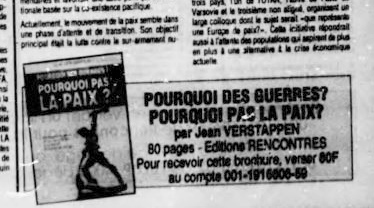 Fig. Advertising for the publication in the Western press.
Fig. Advertising for the publication in the Western press.
A thousand copies were sent to various addresses using Verstappen's contacts. The publication was freely distributed during the peaceful demonstrations and celebrations of 1 May organized by the Belgian Workers' Party. In the evaluation of the operation, "Krupka" the handler stated that: "From the very beginning, "PEN" approached our AM very pro-actively and based on the propositions sent by the Centre, drafted very well-informed material fully in line with our principal interests, criticism of US right-wing politics. …In the course of implementation, we also managed to get repeated positive reviews in the magazines Recontre, Paix and Nia Voko. P's help in deepening the impact of the AM can also be evaluated positively, when, on the basis of a request of KP [editor's note: an intelligence officer], he had an Esperanto translation made, which is currently being used for AM DVA II.“12
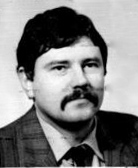 Fig. Maj. Jan "Krupka" Braňka, source: ABS
Fig. Maj. Jan "Krupka" Braňka, source: ABS
AM MACH and AM TLO
Another similar operation involved collaboration with the East German intelligence agency HVA (Hauptverwaltung Aufklärung), where the Czechoslovak side provided background material prepared by a confidant with the code name "Assistant". The actual implementation of the operation was conducted by the German side and resulted in AM MACH and AM TLO in the form of processing two book publications. In the case of AM MACH it was a book written by the German “author” Gerhard Kade. The book was entitled "The Benefits of Star Wars" subtitled "Facts and Fables". It was published in West Germany in the summer of 1987. Gerhard Kade was a German author and published several books. After leaving university he worked for "KOFAZE" (Committee for Peace, Disarmament and Cooperation) and was later also a member of the Center for Marxist Peace Research, which had a direct link to the German Communist Party operating in West Germany. Kade was a Stasi agent with the code name Super. Information about the second publication was not provided to the Czechoslovak side due to a conspiracy.
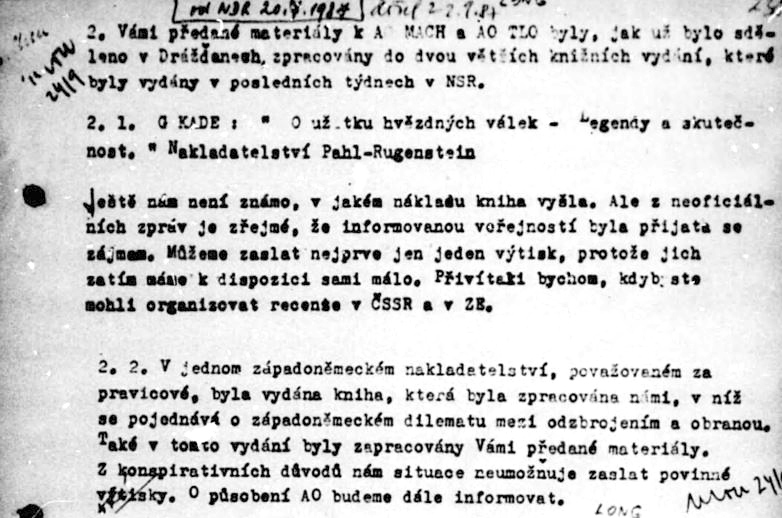
AM DOVOZ

Fig. Czechoslovak intelligence ideological collaborator "Jája" - Prof. Ing. Jaroslav Jakš (1937 - 2019), source: imup.cz
The aim of AM DOVOZ was “To deepen the differences of opinion between the Member States of the European Community and the USA on trade with Eastern Bloc countries. By highlighting the advantages of restricting trade for the United States, stimulating debate on the need for greater autonomy in trade relations between the countries of Eastern and Western Europe, thereby worsening America's position in Europe". 13 Major Bohuslav "Novotný" Novosad of → Section 80 of Directorate I (Section for intelligence activities from the CSSR). The active measure took the form of a brochure and the information in it was taken exclusively from books by Western authors. The text itself was written by ideological collaborator Jája, after consultation with Col. Václav "Mourek" Moc of Section 36 Jája.14
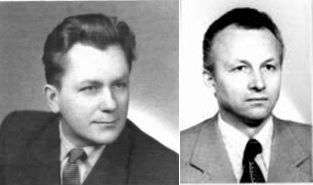 Fig. Left, Col. Václav "Mourek" Moc and Major. Bohuslav "Novotný" Novosad (on the right). Photo: ABS
Fig. Left, Col. Václav "Mourek" Moc and Major. Bohuslav "Novotný" Novosad (on the right). Photo: ABS
The brochure was divided into 4 chapters and detailed the following propositions:
After the optimism of the 1960s, there was a turnaround in the 1970s and 1980s as a result of new US policy, which political and economic circles in the West are receiving differently. The problem is this new policy, especially for West Germany's relationship with East Germany.
The "Soviet threat" has been operating in the West for years, but is always explained differently. The Reagan administration exaggerates what it can. At the same time, it seeks to impose its ideas on Western Europe (WE). It strives for leadership and not for a US-WE partnership. This affects the whole network of relationships between East and West. In particular, the economic interests of the West and the USA in developing relationships with the East are different. The US and WE also differently evaluate Glasnost and the possibility of influencing developments in the East with the help of embargos. This leads to the fact that WE is not even unified in its relations with the USA. Everyone has gained more or less from Glasnost. Since WE is more dependent on foreign trade, economic relations are more important to its countries. Trade with the East is interesting and necessary for WE, and embargos should not cause the economic quarantine of the East. The development of economic relations will improve the atmosphere and thus reduce the risk of a conflict that would prove devastating to WE”.
The book was translated into French, but despite several attempts, the Czechoslovak intelligence service could not find a "suitable channel" for publication. Therefore, Chief of Section 36 Col. Václav "Stárek" Smíšek turned to his long-time colleague Col. Dima Stankov, Chief of the Active Measures Section of Bulgarian Intelligence, and offered him the prepared material. Bulgarian intelligence found a suitable channel and 5000 French copies of Are there still any prospects for West-East trade cooperation? were put into circulation in Portugal. According to information from the Bulgarian intelligence service, the book was disseminated to further addressees in Portugal and other Western European countries via the publisher. At the beginning of 1988, it was spread by a publishing network to third world countries, Canada and the USA.
Fig. The working meeting between the Czechoslovak and Bulgarian Intelligence AM departments in April 1989. The subject of the meeting was also AM DVA. Source: ABS
The Issue of AIDS
Today, the myth about the spread of HIV often comes up in connection with the "popularization" of Russian disinformation campaigns.15 We look at this topic in more detail elsewhere in the article about Operation DENVER and about AM AIDS. The fact that former Eastern Bloc services actively cooperated in disseminating disinformation about the creation of AIDS in US laboratories is easily verifiable in local archives. Czechoslovak intelligence also participated in a relatively successful global operation and dissemination of AIDS disinformation in the mid-1980s. It was a long-term active measure with the code name DETRICK with several segmented suboperations.16 There was also cooperation with East German intelligence to spread disinformation. During talks in Berlin, AM Section officials from the German service reported that they “are working on the issue of AIDS with considerable effort, which they even plan to increase. In all operations, they emphasize the US's involvement and experiments on people in Fort Detrick. There is no need to go back to whether the disease originated in Africa. They are trying to shift at least part of the operation to US territory. They are currently publishing in Uruguay where they have a channel. They are preparing an hour-long TV programme for West Germany. After broadcasting, it will be sent to us for information purposes and possible purchase by Czechoslovak television.“17
Particular attention was paid to AMs which aimed to disrupt relations within NATO, as well as actions disrupting relations between the US and West Germany. One such operation, which at the same time got onto the list of most successful AMs in 1986, 1987 and 1988 – rated as particularly effective – was operation REHAN. The aim of this active measure was to stimulate anti-American sentiment in Bavaria by spreading fictional information about the United States' interest in building a military training ground in the area "and at the same time criticizing Strauss18, as an advocate of US interests within West Germany. The AM was carried out in the form of a fake letter (information about the planned training grounds and invitations to a protest rally), fake flyers sent on behalf of an environmental protection organization, attacking Strauss and others.“19
Conclusion
These examples are, of course, only a fraction of the total number of active measures against the US, NATO, Germany and their allies. They were produced by Czechoslovak Communist intelligence at the request and under the watchful eye of the Soviet KGB. Although today's world is no longer clearly polarised and the situation has changed 30 years after the fall of communism, one thing remains almost unchanged. It is the attitude of non-democratic, autocratic regimes (their leaders) denying human rights versus those (countries, institutions, individuals) for whom freedom is something worth fighting for and worth promoting. This clash did not disappear with the end of the bipolar world, but may have less obvious contours. But it is still present, along with Russia's paranoid perception of threat and the need to defend itself against attack. Although it is the defence of a totalitarian form of government against an often non-existent threat. If one of the forms of Russian defence is active measures, it is good to learn from the past. For "the better we know our past, the better we are prepared for the future".
Author: Martin Slávik
1 The conducting of effective active measures - one of the main tasks of Czechoslovak intelligence. ABS f. I. S-ZNB. SF 01, p.3
2 Active measure documents, which has been bundled in accordance with relevant registration directives (files of active measures - referred to as file volume 9), was unfortunately particularly affected by desperate shredding in late 1989 and early 1990. I would go as far as to say that StB members destroyed more than 95% of documents containing information about specific operations carried out by them. The preserved material makes up a really small percentage of the originals - as can clearly be seen from the preserved lists of documents (parts of files) originally contained therein. It is clear that the parts of files (subfolders) containing detailed information about the active measures where the targets of the most intensive shredding.
3 For more details on this period, see e.g. Martin Slávik: StB and KGB Intelligence Co-operation on Active Measures. In: Activities of the NKVD / KGB and their cooperation with the secret services of Central and Eastern Europe 1945–1989 II. International conference book. ÚSTR, Prague 2009 p. 175-184
4 ABS, f. I.S-SNB, reg. no. 81282/114 Background Materials for the Meeting of Chiefs of Intelligence of the USSR SSR, 16.2. 1982
5 Martin Slávik: StB and KGB Intelligence Co-operation on Active Measures. In: Activities of the NKVD / KGB and their cooperation with the secret services of Central and Eastern Europe 1945–1989 II. International conference book. ÚSTR, Prague 2009 p. 175-184
6 Detailed information on these operations has not been preserved, information about them can be found in the volumes of operational correspondence, ABS, f. I.S-SNB, reg. no .: 81282/114 and 108.Detailed information on these operations has not been preserved, information about them can be found in the volumes of operational correspondence, ABS, f. I.S-SNB, reg. no .: 81282/114 and 108.
7 ABS, f. I.S-SNB, reg. no. 90060/221.
8 ABS, f. I.S-SNB, reg. no. 90060/238
9 Ibid
10 Ibid
12 ABS, f. I.S-SNB, reg. no. 90060/238
13 ABS, f. I.S-SNB, reg. no. 90060/261
14 Real Name Jaroslav Jakš.
15 E.g. the New York Times.
16 The materials of specific operations have not been preserved.
17 ABS, f. I. S-SNB, reg. no. 90083. Operation Sepia - Recording.
18 F. J. Strauss was the long-term chairman of the CSU and also the Minister President of Bavaria.
19 ABS, f. I.S-SNB, SF 474. Overview of most effective AMs for 1986, 87, 88.




